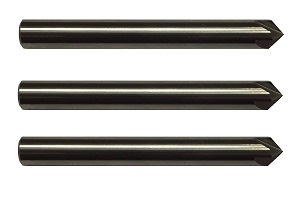As it often happens in the manufacturing industry, subtractive machining involves several vital steps. After performing all the necessary cuts, a piece needs to go through a finishing process to smooth out surfaces and add the final details to the part you are working on.

The most important tool in your arsenal for finishing tasks should be the chamfer mill. Chamfering usually means removing material from rough edges and creating a transitional surface, effectively eliminating sharp angles that could be both dangerous and unappealing.
Pieces that have sharp angles, usually 90 degrees or below, often require us to create an intermediate side or chamfer between the two intersecting sides. However, there are times when a bevel is recommended. In this case, you require a tool that can modify the end of a piece to create a sloping surface.
Chamfer mills are the best tools for these kinds of cuts as they efficiently remove enough material to create a transition angle or make the two sides of a piece meet at a sharper angle.
Typical chamfer mills can come in many shapes and sizes so there is always a right cutter for your project. However, there are some general features that most chamfer mills share.
Your regular chamfer mill will have a simple but robust straight shank able to withstand lateral forces. They will also feature a fluted pointed tip that will be used to create angled surfaces. All of the cutting forces will be found in these sharp flutes that rarely go up the shank, and the point angle will determine the shape of the cut. Chamfer mills usually come in 90 and 60 degrees varieties, but you can also find other angles manufactured by carbide chamfer mill providers.
Depending on the operation you run and the materials you cut, you will need specific cutting tools. For example, some operations and workshops will benefit from using steel tools as they can deal with a wide variety of materials. However, when cutting hardened metals such as steel and non-ferrous alloys, nothing beats carbide chamfer mills. The nature of composite materials makes them harder and more durable than steel-based tools, giving them the ability to last up to 10 times longer and deal with temperatures up to 4 times higher. These qualities make carbide a superior material even for softer materials such as wood as its atom-sharp edges help tools find purchase more easily and go easy on the grain, consistently producing smooth finishes.
Chamfer mills also excel at deburring tasks. This is especially important after milling tasks that leave sharp burs on the edges of a piece. Manual deburring is a time-consuming task that can also take a great toll on those who have to perform it manually. A high-quality carbide chamfer mill can take care of all your edges, removing these burrs in one pass and saving time and money.
Many workshops have adopted these versatile tools for tasks that usually require other specialized heads. For example, the tool´s sharp point makes it ideal for creating notches and making small engravings on a piece. The tool can easily perform drilling tasks due to its geometry, which gives it a place when you need to do some spot drilling or countersinking. If used wisely, a chamfer mill can help reduce tool change downtime and speed up production.
However, all these advantages can only be attained if you use high-performance cutting tools from trusted manufacturers. Online Carbide is an American carbide tool manufacturing company that specializes in crafting a wider variety of cutting tools such as chamfer mills, spot drills, end mills, and much more. Visit their website, or contact them at sales@onlinecarbide.com.
For more information about Variable Flute End Mills and Spot Drills Please visit: Online Carbide.
Hi, I am Adam Smith, Admin Of TechSketcher, Creative blogger and Digital Marketer.